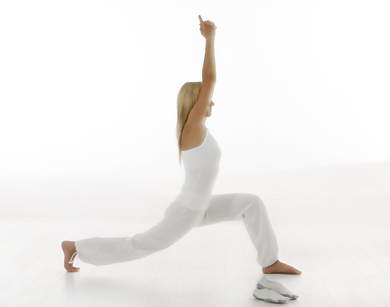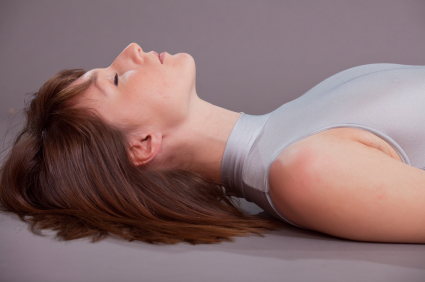Guyside: Do you have recovery time covered in your exercise?
Yoga. How hard can that be, right? Just a bunch women accessorizing and lying around on mats, right?
Uh-uh. As I type this, my large thigh muscles are complaining, and my abdominal muscles are providing harmony vocals. All this after an “ambitious” session of Kundalini yoga on Monday. As in so many instances, my pain is my fault, for two reasons:
- I have had a fairly indolent fall, with not nearly the same level of activity — yoga or otherwise — that I might expect normally.
- Being reasonably competitive and interested in seeing what others were doing in the class, I wanted to show that I wasn’t some Kundalini newbie. So I pushed myself.
And here I sit, waiting for my muscles to stop being mad at me.
Time was that such foolhardiness on my part wouldn’t have been NEARLY as big a deal. Gluttony, sudden spurts of exercise, alcoholic overindulgence, nights with very little sleep — it all was part of the game, and I (or at least I think) was able to perform quite fine under all sorts of self-imposed constraints. Now, it’s a different story. I can have late nights, but there will be a price to pay. The days of 80-chicken-wing sprees accompanied by pitchers of beer? Gone. And as my yoga experience has shown me (not for the first time), I need to gauge my level of effort when exercising and prepare for recovery time.
And it’s not just me. Science says so. An article in the Encyclopedia of Sports Medicine and Science states baldly that “The recommended dose of exercise should do no more than leave the participant pleasantly tired on the following day. Recovery processes proceed slowly, and vigorous training should thus be pursued on alternate days.” And a Harvard Men’s Health Watch article points out (too late for me this time) that it’s best to “Work yourself back into shape gradually after a layoff, particularly after illness or injury.”
This week, I brought my bike in from the garage to set it up for winter training. If I have learned one thing from Monday’s yoga class, it’s that while I can do stuff, I can do stuff better if I do it with an eye to gently bringing myself up to speed, rather than exploding out of the gate.
And the benefits of physical activity are so great and diverse that there’s no argument against moving a bit more. Now, can someone pass the Ben-Gay?
Photo: cc-licenced image from Flickr user Jamie Ramos.
Read MoreLife quality and yoga
Perimenopausal? Menopausal? Are you having difficult sleeping, mood swings, lack of focus and diminished energy? How’s your sexual functioning?
Take one look at that list of woes and it’s no wonder that women sometime want to tear their hair out during menopause. However, there is evidence that attenuating symptoms can help improve quality of life and that certain interventions, including exercise, yoga and/or omega-3 supplements can help.
Medical experts continue to question the value of these interventions during the ‘pause, citing a lack of scientific evidence and conflicting study results. Some even go so far to refer to strategies other than hormone replacement or some other pharmaceutical intervention as ‘snake oil.’ Yet, data continue to evolve that thinking outside the HRT box may help some women and it is for this reason that I wanted to share some newly-published study findings with you.
This latest MsFLASH (Menopausal Strategies: Finding Lasting Answers for Symptoms and Health) study examined 338 women who were randomly assigned to 12 weeks of studio and in home yoga, tri-weekly 40 t0 60 minutes moderate-level cardiovascular training sessions or usual activity. The women were also given and asked to take a daily omega-3 or placebo capsule. Consequently, they were asked to score factors that impact quality of life during menopause, things like vasomotor symptoms, physical functioning, pyschosocial impact and sexual functioning.
The results?
Women who practiced yoga appeared to achieve small but still greater improvements in their overall quality of life (on the basis of the factor scores mentioned above) versus the other inventions. Moreover, it appeared that yoga reduced the extent to which women found their hot flashes bothersome or interfering with daily functioning. Apparently, neither exercise or omega-3s impacted these measures.
The reason for this potential improvement has to do with yoga’s theoretical impact on how balanced the sympathetic nervous system remains in the face of midlife stress and hormonal imbalances. Yoga may help maintain balance and how well or positively we perceive the world around us.
Despite the small, incremental benefit provided by yoga versus exercise or omega-3 supplementation alone, it’s important to emphasize that very few studies have focused on quality of life specifically as it relates to yoga. And, while previous studies have shown benefit, getting women to ‘go the distance’ during these studies has proven difficult.
Mind you, by no means do these study findings suggest that you should give up exercise or omega-3s and switch to yoga. Both of the former strategies have their own benefits. But you may want to consider your quality of life and actions to improve it during menopause and beyond. Yoga practice may be an important part of the puzzle.
Read MoreNewsflash: Yoga and hot flashes
When it comes to alternative strategies for managing hot flashes, where do you turn? I’ve been writing about alternatives for five years now and the only thing I am fairly certain of is that what works for one woman doesn’t necessarily work for the next. Consider the management of menopausal symptoms similar to the management of any condition: the best treatment is always individualized.
Still, mind-body practices tend to rise to fore and evidence continues to accumulate supporting their value and usefulness. This is especially true of meditation, and of yoga.
The latest news on yoga comes from the online edition of Menopause journal and researchers are saying that integral yoga practice may help to reduce hot flash frequency among some women.
Integral yoga integrates the various branches of yoga and focuses on a whole body approach with the goal of transforming the entire being. Experts say that it is especially well suited to hot flashes because it emphasizes stress reduction and decreasing the likelihood of becoming overheated.
To evaluate its usefulness in a more scientific setting, researchers asked a small group of women in perimenopause who reported at least four hot flashes a day to participate in 10 weekly, 90-minutes integral yoga classes comprising breathing, centering medication, physical postures and deep relaxation, or health and wellness classes on different topics relevant to menopause and midlife women’s health or no interventions at all. All had the option to join classes at any time, and were required to fill out diaries about their flashes.
The findings? The researchers say that even after controlling for a potential placebo effect, both the yoga and health and wellness groups tended to follow a similar pattern and a similar significant decline in hot flash frequency. Women in these groups reported an estimated 66% (yoga) and 63% (health/wellness) decrease in the frequency of their hot flashes. And, while the effectiveness of yoga to lower hot flash frequency was not considerably different than that of the health/wellness education classes, the inclusion of the two behavioral interventions may perhaps capture naysayers’ attention; most studies only include on behavioral intervention and having two helps to temper bias.
We need more studies like this one to tease out the benefits of behavioral interventions. The good news is that the information is there for those who look deeply enough.
Read MoreWednesday Bubble: Can yoga decrease insomnia, improve sleep quality?
I love that yoga practice continues to take center stage in Western medicine. Truly, this is mind boggling because rarely, if ever, has an alternative practice been given so much credence within the confines of a medical philosophy that allows little outside the box. However, just a few weeks ago, yoga made the headlines again with data showing that it might be useful for treating lower back pain than standard therapies.
In menopause, yoga practice has been explored for stress relief, to improve wellbeing and as a tonic for vasomotor symptoms. Notably, the latter are considered to be partially responsible for significant sleep issues that occur during and after menopause. Indeed, some data show that up to 81% to 83% of women may have sleep complaints and 52%, insomnia.
Yet, like many strategies, yoga is not a one size fits all practice and there are many branches and types, some being meditative and others breathing, and some more physical than others. These distinctions can make it difficult to standardize studies and apply their results. Still, I was thrilled to stumble across a study evaluating the effects of a specifics sequence of yoga on physical and mental health, and symptoms in menopausal women experiencing insomnia. Importantly, this study used a scientific, randomized controlled design to insure that test conditions were up to par with Western methodological standards.
Basically, researchers assigned 44 menopausal women diagnosed with insomnia to one of three group:
- a control group who ingested 500 mg calcium daily
- a passive stretching group, who participated in two, one hour passive stretching classes a week (including stretching of back, stomach, ankles, knee, thigh, elbow, shoulder, wrist and neck) or,
- a yoga group consisting of two, one hour sessions weekly. These yoga sessions were based on a sequence using stretching positions (asanas) with strong and fast breathing (bhastrika) followed by directed relaxation.
Women in these groups also took 500 m g calcium daily.
The study, which lasted for four months, showed that engaging in a particular sequence of yoga significantly reduced vasomotor symptoms and improved sleep/insomnia severity and mental health compared to passive stretching or simply taking calcium. Women who took the biweekly yoga classes also had higher quality of life scores and better resistance to stress. And while the passive stretching group certainly did not do as well, they did trend towards these benefits as well, especially with regards to the degree of reported stress in their lives.
The researchers believe that regular yoga practice, at least with these particular sequences, alters the nervous system and increases brain concentrations of a potent neurotransmitter – λ-aminobutyric acid – to help improve sleep patterns and reduce vasomotor symptoms. Likewise, stretching may lead to a state of calm that results in reduced metabolism, heart rate, blood pressure, breathing and muscle tension, all of which contribute to stress (or stress reduction).
Granted, this is a small study but it was rigorously designed and suggests that yoga may help sleep issues associated with aging and menopause. I, for one, want to run into a yoga studio. I don’t recall the last time my zzzz’s were not interrupted.
Read More










